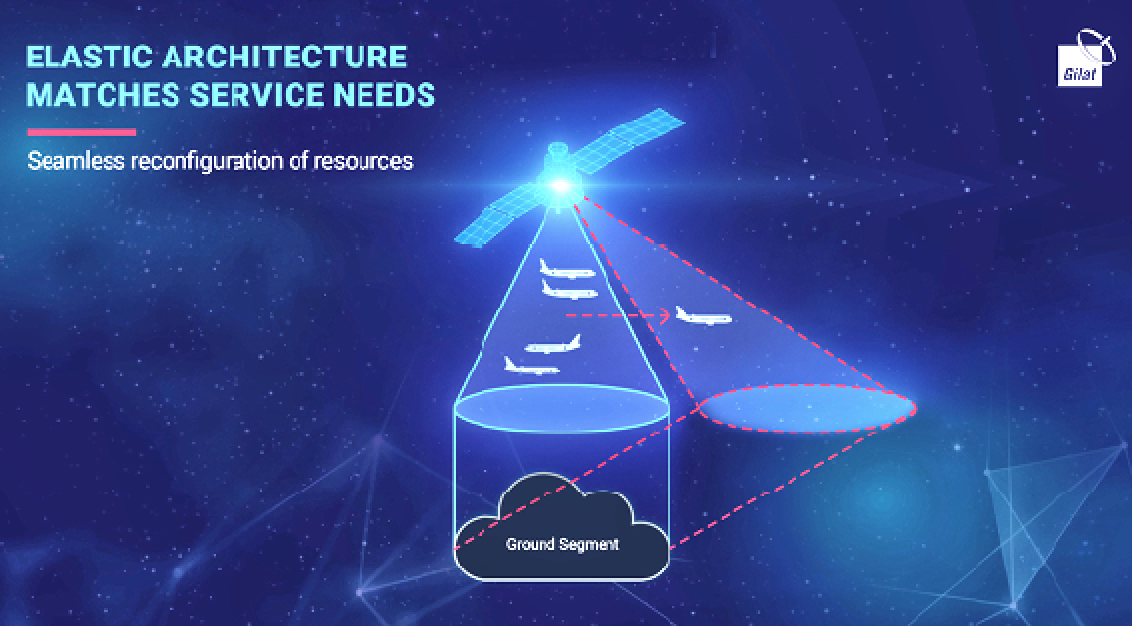Agility, flexibility and scalability are required for the “Elastic Era”
Just about everyone acknowledges the importance of Internet connectivity to foster economic growth, drive social inclusion and meet consumer demand. It is also widely understood that satellite communication can significantly assist by delivering bandwidth to regions that lack terrestrial connectivity and to moving platforms such as airplanes, cruise ships and other commercial vessels.

However, to meet the growing demands of a truly connected world, the satellite communication industry is going through a fundamental transformation. Next generation satellite technology is evolving to multi-orbit constellations that include Non-Geostationary Orbit (NGSO) constellations, Very High Throughput Satellites (VHTS) as well as traditional Geosynchronous Earth Orbit (GEO) satellites.
At Gilat, we refer to this next generation as the Elastic Era of satellite communication, that will deliver greater agility, flexibility and scalability utilizing cloud technologies and Software Defined Networking (SDN).

The Elastic Era, the next generation of satellite communication, will more accurately and efficiently focus resources on actual demand at minimal costs. This transformation will address the major satellite industry challenges of delivering affordable higher throughput services, with ensured availability and lower latency.
Both the ground segment and the new generation of satellites, regardless of orbit, will be software-defined. The new satellites of the Elastic Era will enable on-the-fly in-orbit programmability of thousands of beams in terms of coverage, bandwidth and power.
Additional functionality is the ability to configure specific beams to track airplanes and ships and thereby to deliver fixed SLA to moving platforms globally.
These new generation satellite capabilities will require smart innovation of the ground segment to provide the needed software-defined platforms to deliver on- the-fly configuration of carriers, higher throughput data processing, and the required flexibility and tight coordination between ground and space.
The key to delivering on the Elastic Era promise of ubiquitous connectivity for fixed and mobility sites, 5G and IoT, is the seamless integration between software-defined satellites and the ground segment, both controlled and managed by smart resource management.
Implications of the Elastic Era on the Ground-Segment
The ground-segment component of next generation satellite communication systems will need to support multiple orbit solutions while exponentially increasing performance, density and flexibility. The ability to be both scalable and agile is precisely what is needed for the Elastic Era.
Gilat’s elastic architecture supports the dynamic needs of the network throughout its ongoing operation. This includes accommodation of day-one operation over a large geographic coverage area, as well as scaling up with increased bandwidth, an increase in users and expanded geographic coverage as well as support during the network maturity phase and accommodating ongoing changing demands.

A significant component of the elastic architecture is the fact that ground-segment scalability is no longer tied to beam structure and peak usage; network scaling is now independent of beam throughput, beam footprint and beam coverage.
The key benefit here is the optimization of ground infrastructure, reducing footprint and costs since hardware is only added when network operation increases, maximizing CAPEX utilization from day-one operation.
The virtualized architecture supports a cloud infrastructure and thereby significantly improves software agility and compute density.
Another component which addresses dynamic network optimization is the programmable SDN. The SDN allows for on-the-fly changes to the beam carrier configuration, which can be modified to increase or decrease capacity to better accommodate service needs, or to mitigate signal fade conditions.
For example, as a large passenger airplane goes through a beam, capacity can be temporarily increased to accommodate the intensified usage. Or, when fade mitigation is required the SDN provides capacity steering to ensure uninterrupted service. The elastic architecture enables seamless reconfiguration of resources.
To allow for real-time changes in terminal throughput demand over specific geographic locations, Gilat’s elastic architecture also allows dynamic capacity steering of resources between beams. It is no longer necessary to allocate the maximum needed carrier size and compute power ahead of time. Due to this, the inefficient “design to peak usage” is no longer required.
Network Performance
The Elastic Era of connectivity requires a tremendous increase in speed.
Next generation VSATs must be designed to serve, with maximum efficiency, data intensive applications. The VSATs must exhibit ultra-high processing capacity, achieving unprecedented high throughputs for both downloads and uploads including high packets per second processing, to meet the high-performance demands. The combination of high throughput and the low latency from NGSO constellations creates an opportunity for delay-sensitive applications to be served by satellite communication.

As an answer to this need, Gilat has launched the Aquarius family of next generation VSATs to address tomorrow’s data and media intensive applications. The Aquarius family of VSATs builds-on Gilat’s long-time expertise and patented technologies and enables more than 2 Gigabits of concurrent speeds and higher packets per second to serve bandwidth hungry applications such as required for 5G connectivity.
Another performance concern of a next generation satellite network is the return access scheme, that must rapidly adjust to the changes in the network. The VSATs must have the flexibility to best address the “moving” satellites as well as high throughput backhauling and mobility applications.
It is essential for the elastic network to have the flexibility such as incorporating different VSAT types on the same beam and various applications on the same network. To meet this challenge, a wide range of return carrier symbol rates are needed to address the variety of applications and their dynamic needs.
Addressing the Challenges of Moving Satellites
Supporting GEO networks has its own set of challenges for the ground-segment. However, the Elastic Era poses additional challenges for the ground-segment; NGSO constellations require that the ground-segment communicate with “moving” satellites.
Gilat’s elastic architecture is designed to address the multi- orbit operation of any satellite constellation, LEO or MEO, including seamless handovers between GEO and NGSO, implementing “make before break” for an uninterrupted user experience. This ensures that service is continuous and that the change of coverage between satellites in different orbits is totally transparent to the end-user.
Furthermore, there are additional complex design considerations for the ground-segment when operating with “moving” satellites,” such as processes for satellite acquisition, initial pointing and VSAT logon, as well as continuous communication while performing seamless satellite handover.
In addition, as these new NGSO satellites are constantly moving relative to each other, the Doppler effect and the dynamic fade of the physical link are significant. These conditions can be mitigated with Gilat’s Air-Interface modifications that include timing synchronization, frequency corrections and power management.
It is important to note that we expect that GEO, MEO and LEO constellations will continue to live in harmony as complementary technologies, each with its own advantages. As such, Gilat’s elastic architecture is designed to provide seamless handover between orbits. This is important to enable multi-orbit, per application and per geographic area with varied service options, and to deliver orbit redundancy. A seamless multi-orbit operation ensures that users can continue to enjoy uninterrupted service being completely oblivious to the orbit switch.
Integrating Satellite and Ground Segment Resources
In conventional networks, the satellite and ground system are managed separately and relatively decoupled. However, in the Elastic Era of satellite connectivity, much tighter integration will be required between satellites and the ground-segment. For this, a Resource Manager (RM) is required. This next generation component will coordinate between the space and ground-segment to address the dynamic changes needed to meet both user demand and network conditions of the elastic network.
The RM will carefully analyze real-time situations as well as anticipate upcoming trends that require smart decisions regarding resource allocations in space and on the ground. The RM will then orchestrate the required changes to both segments simultaneously, in a unified and streamlined manner. For example, creating a new beam in space and generating a new carrier on the ground must be coordinated from one central place, to ensure reliable and fast network operation.
In order for the Resource Manager to make optimal ongoing decisions on current network requirements, it must receive from the ground-segment real-time input on the network’s status such as: per beam user demand, links’ utilization, fade conditions and user locations. In addition, the RM must receive detailed information on the status of the resources from both the ground and space segments.
Gilat’s SDN platform is designed to provide the required high agility by enabling fast steering of platform resources in addition to providing high quality big-data collection that is used as input to the RM’s smart decision making. This is done with a robust open interface that supports streaming of large volumes of information to the RM.
Gilat’s next generation ground-system is designed to be able to monitor and collect detailed accurate information in real-time and at a high resolution, on all elements of the network. The ground-system must also have the intelligence to receive input from the RM in order to smoothly and seamlessly execute configuration changes without service interruption. It is the agility of the elastic architecture that steers network resources from place to place.
Change for the Better

The Elastic Era will go a long way in bridging the digital divide; billions of devices will now be able to access low latency real-time applications that will unleash new market opportunities where satellite communication was previously unfeasible or commercially challenging. It will support bandwidth intensive applications such as 5G cellular backhaul, video conferencing, tele-medicine, banking/trading, IoT aggregation and other cloud-based applications. It will also add additional communication capabilities to markets already using satellite connectivity including maritime, commercial/business aviation, education, government and rich media services.
The Elastic Era of satellite communication is creating a gradual but profound change in our digital lives and that will influence all aspects of our existence.
www.gilat.com/#
Author Doreet Oren (doreeto@gilat.com) is Director of Product Marketing & Corporate Communications for Gilat Satellite Networks. Doreet Oren has been in this role since 2012 and has been responsible for defining product positioning, messaging, go-to-market strategies, market research, and analyst relations.

Oren has more than 20 years of industry experience, and has held management positions in R&D, product management and product marketing, for international high-tech companies. In this capacity she contributed to next generation product definition and was responsible for delivering the company’s vision to the media and analyst community.
Doreet has published thought leadership articles in renowned international journals, and has spoken at numerous industry conferences worldwide. Oren received a BSc in Computer Science from George Washington University.

